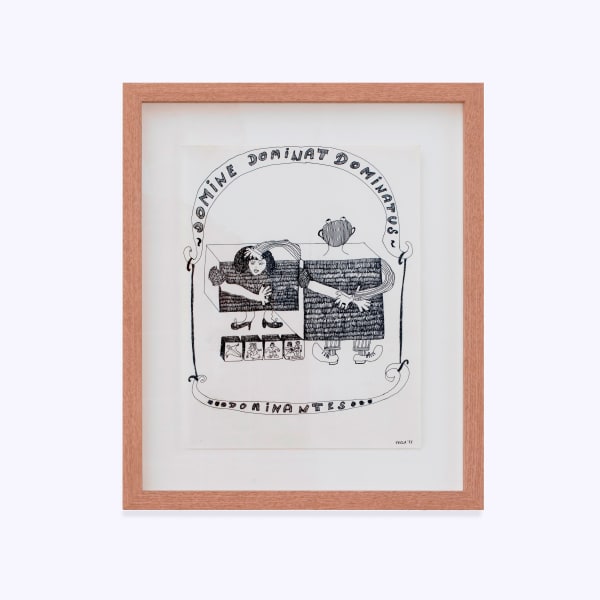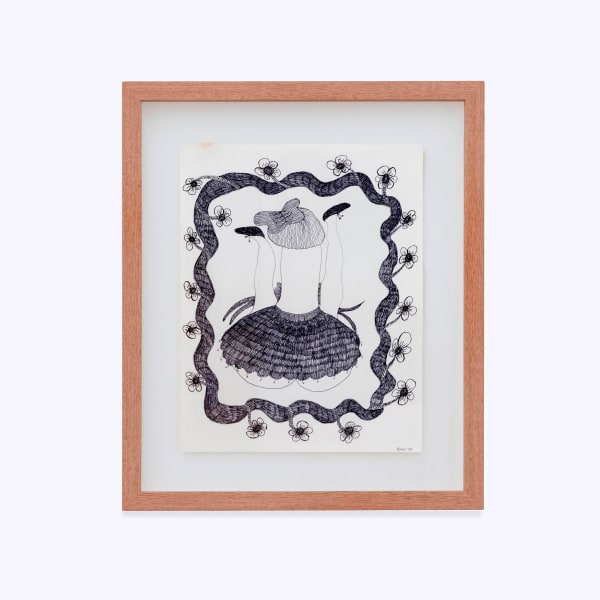-
Disobedient Bodies:
Without Gods, Patrons or MysteriesCurated by Rolando J. Carmona
March 23 – May 18 2024
-
Baró Galeria is pleased to present ‘Disobedient Bodies: Without Gods, Patrons or Mysteries’, curated by Rolando J. Carmona, opening on March 23, coinciding with Art Palma Brunch.
The exhibition features the work of the artists Maitha Abdalla (UAE), Rafaela Baroni (Venezuela), Brandon Gercara (Réunion), Blanca Haddad (Venezuela), Kubra Khademi (Afghanistan), Rusudan Khizanishvili (Georgia), Esmeralda Kosmatopoulos (Egypt), Violeta Quispe (Peru), Amparo Sard (Spain), Citra Sasmita (Indonesia) and Tecla Tofano (Venezuela).
Sponsored by the Consell de Mallorca.
It’s my life, is your shadow
-Aérea NegrotLet's talk about bodies that must shape spirituality to reinvent themselves as women, about magic, and about a silent feminism made by racialized bodies that blur the patriarchy from symbols and encrypted gestures... A discourse of women who challenge their gods without giving up their love for them.
When a sacred text declares that a woman's body is impure or useless, how should the rest of the women in her community respond? Cleanse it or condemn it? Protect it and allow it to exist in all its challenging, fragile, and dazzling beauty?
"Disobedient Bodies: Without Gods, Patrons or Mysteries" brings together artists who have the courage to redefine femininity within their respective cultures. These women, first and foremost artists, emancipate themselves from leaders, patrons, or deities, even challenging spiritual norms, to flourish from the deepest shadows of patriarchy. Each work presented here speaks of methods that go beyond the feminism recorded by historians of white artists, emerging from the farthest corners of large cities.
What happens when a woman loses the traditional role of being functional? The role of giving pleasure, being beautiful and delicate, giving birth, or taking care of the house. In this project, we want to talk about that moment when women become "impure" in the eyes of other women, men's morals, and even the religion professed by their mothers. The code of resistance here is different. In some cases, it is even a non-verbal language, such as that developed by Afghan women in the hammams, discovering a more intense pleasure in a fleeting exchange of glances than in all the moments of fecundity that gave life to their children. Women who become mythical in their communities, like those fierce dragon tamers depicted by Afghan artist Kubra Khademi, who, like a wild beast, escaped forced marriages to marry the only thing she truly loves: art and her freedom.
Women, almost like silent beasts, in the style of Maitha Abdalla who takes advantage of the performative and constructed nature of theater to address themes ranging from folklore and mythology to gender, social conditioning, and psychology. For the artist, the theater is a space where she can confront and destabilize what she has encountered in her social world, her imaginations, memories, and fantasies at an objective distance. The fantastic scenes of the artist oscillate between abstraction and representation and are loaded with drama and melancholy. Abdalla's art constitutes a continuous investigation of the self. She constructs characters that embody a distinctive vector of her person, often enclosed in narrow domestic spaces that expose their vulnerability. The exhibition is composed of artists who could be labeled by some radicals in their communities as impure women, challenging interpretations of the Quran, Hinduism, and even the Catholic Church in rural contexts.
Take, for example, the self-portrait of Rafaela Baroni (ALEAFAR), the goddess of birds. A sculptor from the Andean mountains who escaped a forced marriage to live hidden in a cemetery, from there she began her aesthetic and spiritual research as a medium between the world of the dead, birds, and humans. Some of her works consisted of fictional marriages in each village she reached, where she found a handsome farmer to spend the night. Since the late 1970s, she began to create happenings pretending her own death, where she controlled her body until reaching a cataleptic state.
Also in the Andean mountains, but in Peru, chola Violeta Quispe continues the family legacy by exploring contemporary themes of the Sarhuina visual tradition with which she coexists and on which she expresses herself from a critical feminist standpoint from a radical, sincere, and poignant poetics that announces a path of liberation for indigenous women and which earned her a place in the 61st edition of the Venice Biennale in 2024.
These women's bodies, not eroticized, are sometimes turned into evil spirits capable of challenging even Muslim mothers, like Greek artist Esmeralda Kosmatopoulos, who tells the story of a Western woman and an Eastern man who defy cultural barriers in their love story, set in Egyptian society. Through "The Jinn from the West," embroidered works that represent the challenges faced by Eastern men pursuing Western women. These pieces, inspired by traditional Egyptian techniques, explore the complexities of intercultural relationships. They illustrate the often misunderstood role of foreign women, known as "agnabeya", highlighting both fascination and apprehension in Arab society towards them. These artworks encapsulate the cultural and social tensions that still exist today under the guise of religion.
Blanca Haddad, descendant of Lebanese in Venezuela, became a kind of cursed poet thanks to the power of her word and her demonic strokes, fragmenting the model of the Arab and Latin woman to show herself as a female who dares not to be perfect, in a country obsessed with beauty queens. The pieces presented here reflect the tremor, the imprecision, and the agitation of the Latin American underground. They are paintings with little color but with a strong and rough stroke. Blanca Haddad is not an artist to adorn, she is an artist to claim the freedom of everything that remains in a certain pure and wild state.
In the same country, more than 50 years ago, Tecla Tofano (Venezuela's representative at the 59th Venice Biennale), Venezuela's first feminist, created the exhibition "Censorship Medium," slapping patriarchy and phallocentrism that controls the media, even highlighting the female archetype that models submissive in front of a complexity that men do not want to see. The result, a sculpture with POP intentions, where a thick phallus with feminine lips blindfolds itself and shows a crest that does not allow us to identify if it is a simple portrait of masculine blindness, a rooster, or something much more complex (women with blindfolded eyes modeling their bodies submissive to the phallus norm). Such was the disgust that this woman generated in conservative 1960s Caracas that as an adult she was raped twice in order to "learn to be a woman," unaware that they were facing an unbreakable and invincible creature, who even dared to politicize the abominations committed against her body.
Each of these impure women is embracing her darkness and developing her own methods of alchemy to rewrite her spirituality and her role in the universe, as Rusudan Khizanishvili (representative of Georgia in the 56th Venice Biennale in 2015) does. In her painting "The Magic Necklace," she evokes a process of self-healing, where the female body is portrayed as a mythical creature licking its wounds. Rusudan places her work between neo-expressionism and symbolic mysticism, drawing inspiration from ancient mythology, symbology, and literature of Eastern Europe. Her canvases bring forth the most animal impulse of women, treating her not only as a figure but as an archetypal heroine embarked on an eternal journey of self-realization. Each stroke tells a story of resistance, strength, and the perpetual dance of transformation, inviting the viewer to delve into the depths of their own existence.
Also, with a zoomorphic intention, Amparo Sard creates female and Kafkaesque creatures blurring reality and fiction. Part insects, part creature, in immense, intimidating female bodies. In her paintings, black colors, deformations, or exaggerated dimensions enable us to see what truly moves us, confronting our inner selves and intuition.
Furthermore, we must not forget Citra Sasmita, an artist from Bali unraveling myths and misconceptions of Balinese art and culture. She profoundly questions the place of women in Asian social hierarchy, endeavoring to dismantle normative gender constructs. By appropriating the Balinese Kamasan style, a traditional practice dating back to the 17th century, Sasmita presents narratives focused on women in her paintings, subverting the content of traditional scrolls and frescoes (usually featuring male protagonists) to portray women as central characters.
Each of these "impure" women embraces her darkness and develops her own methods of alchemy to redefine her spirituality and her role in the universe. It's a journey that culminates in front of the black sands of Réunion Island with a sarcastic and moving tone in "Lipstick," where Brandon Gercara, in an act of intersectionality, appropriates the voices of three prominent activists on feminism in France and the Middle East, reminding us that, in different corners, different bodies, and in front of different gods, the struggle remains the same.
Rolando J. Carmona
-
Space 1
-
-
Space 2
-




























